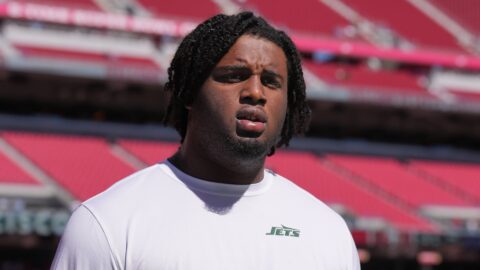FOXBORO, Mass. — Any player who has submitted his resume to become the Patriots' third wide receiver in 2010 needs to possess three things: accountability, one left hand and one right hand.
The job is important, and the responsibilities can't be taken halfheartedly. If it's done right, quarterback Tom Brady won't have a very hard time making you look pretty good for three hours every Sunday. If it's done poorly, you'll look like a 38-year-old Joey Galloway, who was either too unwilling to adjust his style or too incompetent to act as a diversion on the opposite side of the field as Randy Moss.
Neither is a strong endorsement.
"The bottom line is just being accountable, being trustworthy, getting to the spot, and he’s going to find you," said David Patten, who has worked with Brady longer than any wide receiver on the roster. "That’s one of the keys to this offense is his ability to go back, dissect the defense and pick out the weaknesses. The bottom line is you just have to do what your role is on any particular play."
Patten is a long shot to make the roster next season — his chances were thwarted when the Pats signed Torry Holt and drafted Taylor Price — but he'll play a significant role throughout New England's offseason camps. Patten can teach Holt, Price, Julian Edelman, Brandon Tate and Sam Aiken and make them better suited to work well in conjunction with Moss and Wes Welker.
Depending on Welker's health, Edelman or Holt figure to play the role of the third wideout option in 2010. Though Brady's third target won't light up the stat sheet, it's important that the receiver is capable enough to justify defensive attention. Defenses could basically ignore Galloway when he was on the field in 2009, and that allowed them to roll their coverage to the other side of the field.
If one guy is useless, and the others are covered up like Eskimos, New England's offense doesn’t stand much of a chance. On the flip side, just think about how much more functional the Patriots were when Edelman was healthy enough to play with Moss and Welker.
Holt sounds disciplined enough to make sure he's a serviceable member of the franchise next season.
"If it's a route that's ran at 16 yards, you can't run that route at 12, 13 yards," Holt said. "For one, the quarterback's not ready, [and] the timing is off. Now, that allows the defensive back to get a quicker read on the route, maybe pick it off. If the route's called for 16, if the route's called for 20, run it at 16, run it at 20. You have to be on the same page with the quarterback at all times. If you can't do it, you can't play."
Simple enough, right? Donte Stallworth, who was the gold standard for this position in 2007, knew what it took. So did Deion Branch in 2002, when he was the third guy behind Troy Brown and Patten. Conversely, players like Galloway in 2009 and Doug Gabriel in 2006 couldn’t get the job done, although Gabriel's supporting cast didn’t have nearly the same level of firepower.
Let's take a look at the Patriots' third most productive wide receiver, in terms of receptions, during the Brady era:
- 2009: Julian Edelman — 37 receptions, 359 yards, one touchdown
- 2007: Donte Stallworth — 46 receptions, 697 yards, three touchdowns
- 2006: Doug Gabriel — 25 receptions, 344 yards, three touchdowns
- 2005: Troy Brown — 39 receptions, 466 yards, two touchdowns
- 2004: Deion Branch — 35 receptions, 454 yards, four touchdowns
- 2003: David Givens — 34 receptions, 510 yards, six touchdowns
- 2002: Deion Branch — 43 receptions, 489 yards, two touchdowns
- 2001: Charles Johnson — 14 receptions, 111 yards, one touchdown
Over eight seasons, that’s a total of 273 receptions for 3,430 yards and 22 touchdowns, or an average of 34.1 receptions, 428.8 yards and 2.8 touchdowns per season. During those eight years, the aforementioned receivers played a combined 100 regular-season games, meaning Brady's third wide receiver option has averaged 2.7 catches and 34.3 yards per contest.
If you throw out Johnson's 2001 season, since he played a very limited role on that team, Brady's third receiver has averaged 37 receptions, 474.1 yards and three touchdowns per season, and 3.0 catches for 38.6 yards per game.
Obviously, those numbers are extremely attainable, especially when Moss and Welker will open up so many opportunities for the third wideout in the pattern. That’s what makes the little things so important. Those details — running the right routes, adjusting to Brady's calls and reading the defense — often make the difference between successful third wide receivers such as Brown, Stallworth and Branch, and failures like Galloway.
Holt understands the opportunity in front of him, and he's made that his top priority from now through camps and into the season.
"First and foremost, I have to continue how [the Patriots] do things," Holt said. "Learn the playbook, get more embedded in the playbook, get more of a feel for what Tom likes, what he doesn't like, get a feel for the coordinator and how he calls plays, so all of those things. That's why I'm here now. I'll be here in the spring and mini-camps, I'll be here all the way up to training camp, trying to get more and more involved and get a feel for what they do offensively.
"I feel the quicker I can do that, the better it is for myself in terms of getting out on the field and helping, being productive. It also helps elevate our football team because now you have another playmaker opposite of Moss or opposite Welker. And then if I can thrive and make plays, I'll create more opportunities for those guys. So I'm just trying to piggyback off one another."



